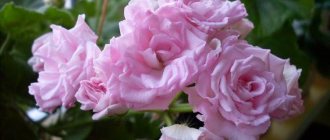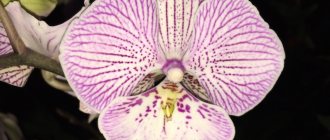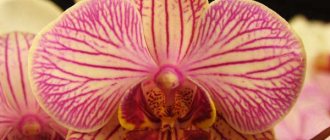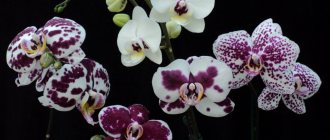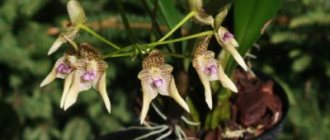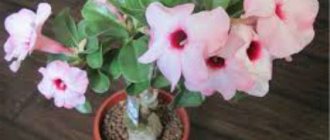Phalaenopsis with yellow flowers are a hybrid type of orchid. Similar to a moth, the yellow orchid is distinguished by its flowering time - about six months, and the buds emit a pleasant smell all this time. This plant is unpretentious in terms of maintenance and care and is rarely affected by diseases and pests. Currently, about 100 varieties of yellow orchids are known that are suitable for home cultivation.
Characteristic
Phalaenopsis yellow is a long-blooming flower with a pleasant smell, honey-colored yellow. Its broad leaves do not require much sunlight.
Like other types of orchids, Phalaenopsis is a small plant with a long peduncle reaching up to half a meter in length.
The name of this plant was given by botanist Karl Blume, who noticed the similarity of the flower with butterflies (Phalaenopsis means butterfly, moth). Phalaenopsis is native to the tropics of Southeast Asia . The main feature of this orchid is that it blooms at any time of the year. Flowering occurs several times a year and lasts up to two months. During this time, about 60 flowers appear on the peduncle.
Color spectrum
In nature, there are a huge number of colors of phalaenopsis , both created by nature (for example: pink, purple, yellow, green, white), and colored by human hands using chemistry (black, blue, indigo, orange). Today we will talk about yellow phalaenopsis.
Yellow phalaenopsis - created by nature. His homeland is considered to be:
- South and Central America.
- Indonesia.
- Southwest Asia.
- India.
- Northern Australia.
But breeders do not stand still. They are constantly developing new varieties of this wonderful plant.
Breeders are developing a new color of yellow phalaenopsis, and are also trying to make the plant feel as comfortable as possible in its home environment.
Varieties and their photos
Phalaenopsis has up to 60 varieties, they mainly differ in shades of color and plant size. The following types of yellow orchids are most often grown at home.
Big Lip
These flowers are distinguished by their very large flowers. The height of the peduncle reaches 80 cm. The leaves are dense, bright green, covered with a thin layer of waxy coating.
Big Lip blooms twice a year, and each plant can have two peduncles. From 4 to 6 large flowers appear on each peduncle.
Multiflora
The Multiflora orchid has a very bright color ; small specks of red or crimson are noticeable on the petals. The leaves are leathery, dense, dark green.
The height of the peduncle reaches 60 cm, 7-9 large flowers appear on it, up to 6 cm in diameter.
Stuartiana
In addition to bright, unusual flowers, a feature of this type of orchid is its variegated leaves. Medium-sized flowers, painted bright yellow with red dots and a variegated center, open along the entire length of the peduncle in quantities of up to 60 pieces. The resulting waterfall of flowers pleases the eye with its blooming for a long time - up to 5 months.
Mini
The mini orchid is small in size, the height of the peduncle does not reach more than 20 cm . It blooms for a very long time, producing arrows in turn with pale yellow flowers and a bright center.
Peloric
Usually flowers of this species have several shades. Yellow color is complemented by pink, red and purple tones. It requires moisture and sunlight more than other species. The peduncle usually reaches 70 cm in height.
Phalaenopsis Pelorik blooms no more than 2 times a year and has a long dormant period.
Stewart
It is distinguished by a very pale, barely noticeable yellow tint of the petals. The peduncle grows up to 70 cm, and about 100 flowers open on it, with a diameter of 5-6 cm.
We invite you to familiarize yourself with varieties of phalaenopsis of other colors - white and cherry Wildcat, pink Liodoro and purple Schiller's orchid.
What to feed
The yellow orchid, like any other plant, needs additional feeding. It is recommended to start fertilizing the next day after the start of flowering. There is no need to start feeding the flower as soon as you bring it from the store. The orchid experiences stress from changes in environment, and fertilizer may cause it to wilt. Wait until the first flowering, and only then start feeding the plant. As a top dressing, use a special complex fertilizer, which should be added to the water for irrigation.
Features of care
Phalaenopsis yellow is considered not a picky plant. It quickly adapts to changing environments; the temperature, light and humidity of city apartments suit it.
For Phalaenopsis you should purchase:
- transparent pot;
- special substrate;
- special fertilizer for orchids.
Suitable soil for growing orchids consists of pine bark, sphagnum peat and charcoal. After flowering, the peduncle will begin to dry out, but there is no need to cut it off immediately. Drying slowly, it releases the remaining nutrients to the plant.
If the peduncle remains green and produces new buds, it does not need to be cut . Soon the plant will bloom again. The peduncle is cut at a distance of 1 cm above the dormant bud, around which wet moss is applied. This will stimulate the appearance of a new outlet.
We invite you to watch a video about the secrets of growing Phalaenopsis orchids:
Cuttings
This propagation method allows you to obtain several yellow orchid seedlings at the same time. It is suitable for those who like to have a lot of flowers at home or give them to someone. When the plant stops blooming, the shoot is divided into parts and cut. There should be one bud left on each separated peduncle. Then the cuttings are treated with special charcoal and placed in a greenhouse for rooting. The conditions created initially will affect the further development of the plant. The room must have high humidity and a temperature not lower than +25 °C.
Watering recommendations
It is enough to water the flower 2 times a week, and it is better to pour the water into a tray. It is necessary to observe the color of the root system, which normally should be green.
Silver color of the roots is a sign of insufficient watering. The brown color of the roots means excess moisture, which can lead to rotting of the horses. During flowering, the peduncle along with the flowers should be sprayed with warm, clean, settled water.
We invite you to watch a video on how to properly water a phalaenopsis orchid:
Rooting of children
Under suitable conditions, orchid babies form independently in leaf axils and on peduncles. If the plant cannot cope with this process, then some measures need to be taken to stimulate it. Sudden temperature changes and increased daylight hours will contribute to the birth of babies.
When the first leaves and aerial roots appear on the new formations, they are torn off from the outlet and planted separately. It happens that the baby does not produce roots for a long time, and this has a detrimental effect on the plant. In this case, it must be separated and rooted separately. If you place a container of water nearby, the baby will reach for it and release the roots faster. There are special means to stimulate this process, but they should be used in extreme cases.
Reproduction
Phalaenopsis The main condition for propagation is that the flower must be absolutely healthy, with a well-developed root system and a basal rosette of 5-8 dense, fleshy leaves. Phalaenopsis can be propagated in several ways:
Reproduction of Phalnopsis by children .
In all varieties of Phalaenopsis, with proper care, not flowers periodically appear on the peduncles, but so-called babies with their aerial roots 3-5 cm long. They can be planted in a separate pot.- first they must be carefully separated from the mother plant;
dry;
- treat the cuts with charcoal;
- after that, place it in a pot with orchid substrate and wait for the growth of a new plant.
- Reproduction by dividing the bush.
Over time, an adult orchid develops several basal rosettes.In early spring, preferably during transplantation, the plant can be divided into several copies. Each will have its own root system and its own leaves.
- using a clean knife, carefully divide the plant, and sprinkle the cut areas with charcoal;
It is better to leave the plant overnight to dry;
- then plant in a pot with soil based on pine bark and charcoal.
- Peduncle cuttings.
This is the most popular method of reproduction.- after the plant has flowered, cut off the peduncle with a disinfected knife and divide it into several parts at least 3-4 cm in length and always with a dormant bud;
the cut areas are sprinkled with coal;
- It is better to plant cuttings in sphagnum moss using a mini-greenhouse or a container with a lid;
- The cuttings are placed in a warm, bright place and soon they begin to grow.
Even if you do not plan to propagate the plant, the children need to be separated; otherwise, over time, too many children can harm the plant, it will weaken and wither.
We invite you to watch a video about the methods and techniques of propagation of phalaenopsis.
1 way:
Method 2:
Landing
Proper planting of an orchid determines its further growth and flowering.
Priming
The most common substrate is pine bark , removed from a cut tree, to which a moisture-intensive component is added - sphagnum moss and expanded clay (foam balls) to improve aeration.
Optimal capacity
The orchid pot must meet the following requirements :
- Have drainage holes;
- Its volume must correspond to the size of the root system;
- Transparent walls will allow you to observe the condition of the roots.
A plastic pot with transparent walls is most convenient for cultivating orchids.
Technology
The orchid should be replanted during the period when it does not bloom :
- To improve drainage, expanded clay (pieces of polystyrene foam) is laid out on 1/4 of the pot’s volume;
- The roots are cleared of the substrate;
- Wash and let dry for about 15 minutes.
Attention! Aerial roots that grew above the surface of the pot are not covered with soil.
When transplanting, the roots are lowered into the pot, the prepared substrate is added and lightly shaken to evenly distribute the soil .
Deadlines
A yellow orchid is replanted only after flowering has finished, otherwise the plant may die. This is best done in the spring during the period of active plant growth.
Diseases
To prevent diseases and pests, it is necessary to inspect the plant a couple of times a month. Phalaenopsis may suffer from the following diseases:
Fusarium .
A very dangerous incurable fungal disease. Appears when unsuitable soil is used, the plant is over-watered, or there is a lack of oxygen and sunlight. It is manifested by the appearance of white spots with a coating at the root rosette. If a plant becomes infected with fusarium, it will have to be destroyed along with the pot, otherwise other flowers may become infected.- Root rot.
Occurs in a humid, warm environment due to excessive watering. The leaves turn a creamy yellow color and the rest of the plant turns brown.If the disease is detected early, the plant can be saved by cutting out the affected areas and treating the wounds with a fungicide. To avoid relapse, place the plant in a cool, dry place for a couple of days.
- Bacterial disease .
Manifested by the appearance of brown spots on the leaves. As soon as you find such a stain, you need to immediately cut it out and treat the remaining damaged sheet with crushed charcoal. Otherwise, the bacteria will spread throughout the plant and it will die. - Viral infections such as Cymbidium mosaic and Odontoglossum virus .
The appearance of stripes or spots on the petals and leaves appears. They first become discolored and then become deformed. The disease cannot be treated and is contagious to other plants, so the flower along with the pot will have to be thrown away.
What conditions do the yellow phalaenopsis orchid need?
Since the plant comes from the tropics and the equatorial zone, it should be provided with an appropriate lighting regime. In those places, the sun rises early and sets late, so daylight hours should not be less than 14 hours. But the light must be diffused. Orchids grow on tree trunks under the canopy of their crowns, so direct sunlight does not fall on them. If the plant is exposed to the scorching sun for a long time, its rosette will become covered with burns and begin to wither and dry out.
Important! Some varieties of orchids do not tolerate shortened daylight hours in temperate zones very well, so in winter it is best to illuminate them with fluorescent lamps.
The root system of plants receives moisture not only from watering. It also absorbs it from the surrounding atmosphere, so the air should not be too dry. In winter, you should be wary of drafts and hypothermia. The most normal temperature for an orchid is 22–27 °C.
Pests
Most often, Phalaenopsis are attacked by pests such as thrips, spider mites, scale insects and aphids. They suck the juice from the plant, disrupting the photosynthesis of the flower. The stems wither and the buds and leaves begin to fall off.
At the first sign of parasites, you need to wash the plant well under a warm shower to wash away most of the pests. Then you need to treat Phalaenopsis with insecticides. It may take several treatments to completely get rid of parasites .
Phalaenopsis is an excellent choice of indoor plant for both experienced and novice gardeners. This hybrid with amber-yellow flowers stands out for its extraordinary beauty. It belongs to hybrids that have taken over their attractiveness from orchids, but is not a capricious plant to care for and enjoys frequent flowering.
What kind of flower is this?
This color of orchid really exists . And its shade variety is great. Shades vary from dark yellow with a slight orange tint to almost scarlet. There are varieties whose inflorescences are colored in orange tones with fragments of pink or red, for example, a contrastingly colored lip of the flower.
This color palette is not the prerogative of any one variety. Thanks to selective breeding, many varieties of orchids have been developed, the list of colors of which includes an orange tone. The most popular types of orchids that have been bred to produce orange flowers are:
- Phalaenopsis.
- Wanda.
- Brassada.
- Ascocenda.
When purchasing a plant, you should be aware of unscrupulous florists who color flowers with a syringe.
Important! When purchasing an orchid of a rare color, make sure that there are no puncture marks under the leaves, on the peduncle or neck of the flower, and that the roots have a natural, green-silver color.


